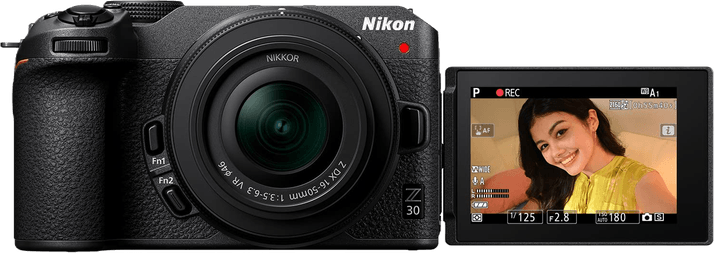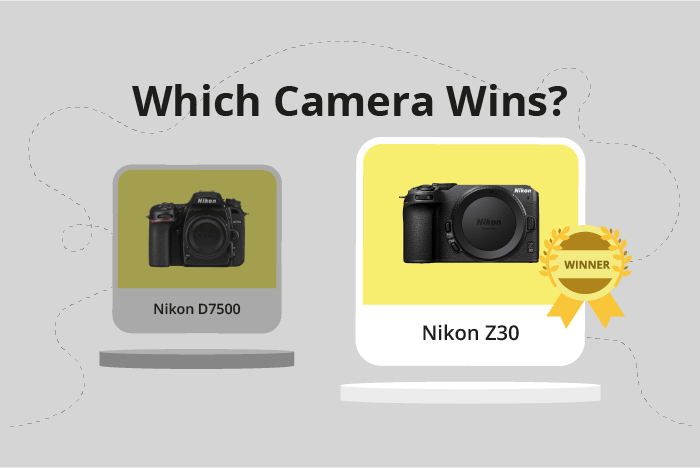Nikon D7500 vs Z30 Comparison
Nikon D7500

Nikon Z30

The Nikon Z30 emerges as the winner with a score of 72/100, while the Nikon D7500 trails close behind at 70/100. Both cameras share similarities in their announcement and release years, with the D7500 announced in 2017 and the Z30 in 2022. They also have comparable launch prices, with the D7500 at $1250 and the Z30 at $710.
The Z30 excels with its mirrorless design, lighter weight of 405g, and smaller size of 128 x 74 x 60mm. These features make it more portable and convenient for photographers on the go. On the other hand, the D7500 has a DSLR design, weighing 720g and measuring 136 x 104 x 73mm. Despite its larger size and weight, the D7500 may offer more stability and a familiar feel for those accustomed to DSLR cameras.
Taking these factors into account, the Nikon Z30’s advantages in portability and weight make it the better choice for many photographers. However, the Nikon D7500’s DSLR design could still appeal to those seeking a more traditional camera experience.
Nikon D7500 vs Z30 Overview and Optics
The Nikon Z30 outperforms the Nikon D7500 in optics with a score of 72/100 compared to the D7500’s 68/100. Both cameras share several specifications, including a CMOS sensor, APS-C sensor size, and no image stabilization. However, there are aspects that set the two cameras apart, making one a better choice depending on the user’s preferences.
The Nikon Z30 boasts a faster shooting speed of 11 frames per second (fps), compared to the D7500’s 8 fps. This difference makes the Z30 more suitable for capturing fast-moving subjects. Additionally, the Z30 has a higher DXOMARK score of 97, indicating better overall image quality, compared to the D7500’s score of 86. The Z30 also benefits from a more advanced Expeed 6 processor, which enhances the camera’s performance and contributes to its higher score.
On the other hand, the Nikon D7500 has a slight advantage in terms of megapixels, with 20.9 compared to the Z30’s 20. This difference might not be significant for most users, but it could be crucial for those who require higher resolution images. The D7500 also uses the Nikon F DX lens mount, which offers a wider selection of lenses compared to the Z30’s Nikon Z mount.
Taking these factors into consideration, the Nikon Z30 is a better choice for users who prioritize faster shooting speed and better image quality, while the Nikon D7500 might be more appealing to those who need higher resolution images and a broader lens selection. Ultimately, the choice between these two cameras depends on individual preferences and specific photography needs.
Nikon D7500 vs Z30 Video Performance
The Nikon Z30 emerges as the winner in the video capabilities comparison, with a score of 91, while the Nikon D7500 scores 70. Both cameras share some common specifications, such as 4K max video resolution and built-in time-lapse functionality. However, the Z30 surpasses the D7500 in certain aspects, making it the better choice for video enthusiasts.
The Nikon Z30 has a higher max video dimension of 3841 x 2160, compared to the D7500’s 3840 x 2160. This slight difference may not be significant for casual users, but professionals may appreciate the extra pixel. More notably, the Z30 has a significantly higher max video frame rate at 120fps, compared to the D7500’s 30fps. This allows for smoother slow-motion footage and more versatility in video projects.
The Nikon D7500, on the other hand, does not have any particular advantages over the Z30 in terms of video capabilities. Its lower score is due to its lower max video frame rate and almost identical max video dimensions.
Taking all factors into account, it is clear that the Nikon Z30 is the superior choice for video capabilities. Its higher video score reflects its better performance in max video dimensions and frame rate. The Nikon D7500, while still a competent camera, falls short in comparison to the Z30 in this category. For those prioritizing video performance, the Nikon Z30 is the recommended choice.
Nikon D7500 vs Z30 Features and Benefits
The Nikon D7500 and Nikon Z30 both have a feature score of 83 out of 100. Although the scores are equal, there are differences in their specifications that may make one camera more suitable for certain users than the other.
Both cameras share several specifications, including touchscreen capabilities, flip screens, WIFI, and Bluetooth connectivity. Neither camera has GPS functionality. These common features make both cameras user-friendly and convenient for photographers who need to easily share their work or control their camera remotely.
The Nikon D7500 has a larger screen size at 3.2 inches compared to the Z30’s 3-inch screen. This larger screen size can make previewing and reviewing images on the D7500 easier and more comfortable. However, the Nikon Z30 has a higher screen resolution of 1,040,000 dots, compared to the D7500’s 922,000 dots. This higher resolution can provide sharper images and more accurate colors when reviewing photos on the Z30.
While both cameras offer many similar features, the D7500’s larger screen size may be more appealing to photographers who prioritize image previewing and reviewing on their camera. On the other hand, the Z30’s higher screen resolution may be more attractive to those who value image sharpness and color accuracy on their camera’s screen.
Considering the equal feature scores and shared specifications, the choice between the Nikon D7500 and Nikon Z30 boils down to personal preferences and priorities. Photographers should carefully weigh the benefits of the D7500’s larger screen size against the Z30’s higher screen resolution to determine which camera best suits their needs.
Nikon D7500 vs Z30 Storage and Battery
The Nikon D7500 outperforms the Nikon Z30 in storage and battery, with a score of 43/100 compared to the Z30’s 35/100. Both cameras have a single memory card slot and accept SD, SDHC, and SDXC cards. However, the D7500 has a significantly longer battery life, offering 950 shots per charge with its EN-EL15a battery, while the Z30 only provides 330 shots using the EN-EL25 battery.
The Z30 does have the advantage of USB charging, which the D7500 lacks. This feature makes it more convenient for on-the-go charging and continuous use. Despite this, the D7500’s superior battery life is more advantageous for extended shooting sessions and reduces the need for frequent battery replacements.
Considering these factors, the Nikon D7500 is the better choice for photographers requiring longer battery life and reliable storage. The Nikon Z30, with its USB charging capability, may be suitable for those prioritizing convenience and portability.
Nikon D7500 vs Z30 – Our Verdict
Are you still undecided about which camera is right for you? Have a look at these popular comparisons that feature the Nikon D7500 or the Nikon Z30:

